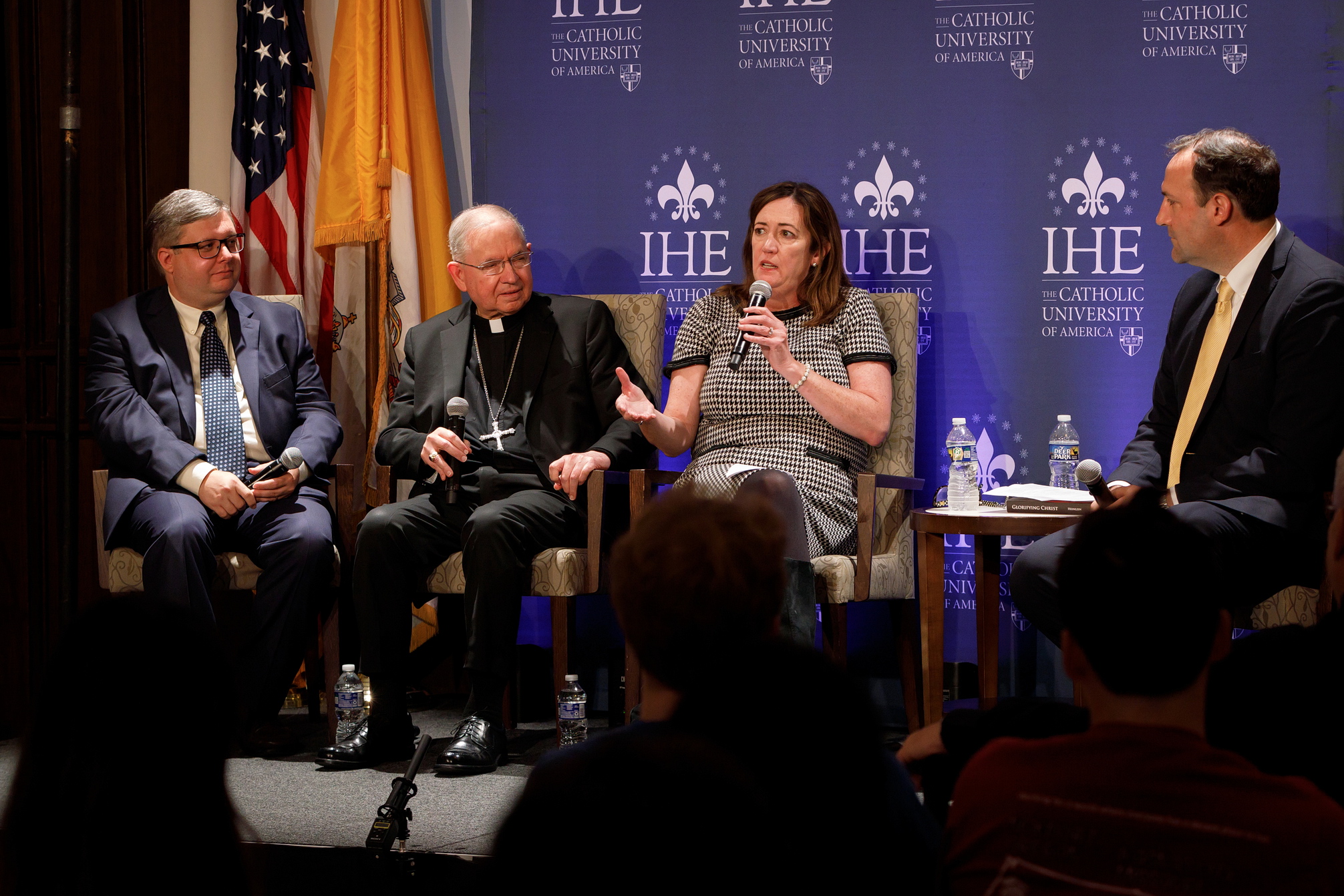

Alumnus and author Michael Heinlein, B.A. 2008, returned to campus last Thursday to discuss his new biography on the late Cardinal Francis George, one of the most prominent figures in the modern Church in the United States. Joining the conversation was Archbishop José Gomez of Los Angeles and Mary FioRito, who shared their personal memories about Cardinal George’s faith, life, and legacy.
Glorifying Christ: The Life of Cardinal Francis E. George, O.M.I. published by Our Sunday Visitor earlier this year, was inspired by the cardinal’s episcopal motto: "To Christ be glory in the Church." The event at Heritage Hall was co-sponsored by the Institute for Human Ecology and The Catholic Project. Stephen White, M.A. 2014, executive director of the project, led the discussion exploring what makes Cardinal George an example of servant leadership.
“I met him several times when I was a student here. I was always impressed with his warmth, his humanity,” said Heinlein. “I believe his story will inspire any Catholic.”
Cardinal George, M.A. 1965, the first native Chicagoan to serve as its archbishop, was initially rejected from seminary because childhood polio left him with a lifelong physical disability. He joined and later led the Missionary Oblates of Mary Immaculate, where he traveled around the globe serving society’s most vulnerable. Known for his intellectual brilliance, he earned two doctorates and was president of the United States Conference of Catholic Bishops from 2007 to 2010. He died in 2015 at 78 after a long struggle with cancer.
“I think he’s an example for anybody who’s ever been dealt a really bad hand in their life,” said FioRito, who was his executive assistant from 2003 until his death. “If you feel God has put something on your heart that he wants you to do something, don’t let the first ‘no’ stop you from doing that,” added FioRito, an attorney who is now the Cardinal George Francis Fellow at the Ethics & Public Policy Center.
Archbishop Gomez, who himself later led the USCCB, said his friend was an “extraordinary example of how to be a bishop.” They initially bonded over their shared background in Hispanic ministry and Archbishop Gomez said he saw a humility in his desire to listen and learn from all those he encountered.
“He was a great theologian. … At the same time, it was clear to me every time that I talked to him that he knew the reality of the needs of the people in the United States,” said Archbishop Gomez.
Heinlein said Cardinal George was known for his towering intellect, notably predicting intensifying polarization we see in the Church and the wider society today. Cardinal George rejected the political terms “liberal” or “conservative” and advocated for what he called “simply Catholicism,” a perspective Heinlein said was rooted in decades of international missionary work.
“He saw Catholicism in all of its facets, so he was able in a very unique way to bring all of that experience to his positions in the U.S. Church,” said Heinlein. “Cardinal George is a model for us today on how to look at the questions dividing us and find a truly Catholic answer.”
Heinlein explained Cardinal George is especially noteworthy as a principal voice for reform in response to the clerical sexual abuse crisis, especially by convincing his fellow U.S. bishops and subsequently the Holy See to adopt a “zero tolerance” policy that would bar the credibly accused from ministry. At a 2019 Vatican summit, Cardinal George was the only bishop held up as a model — by an abuse survivor — for ministry to survivors.
As Heinlein describes in his book, Cardinal George relied on prayer to inform his actions through the many challenges he faced, including reforming the chancery office’s response to clergy sexual abuse cases, in the archdiocese. In 2006, Cardinal George faced a scandal after he failed to remove a priest later convicted of sexually abusing children. Heinlein said Cardinal George discovered that essential information was not passed to him by his staff. He invited a former FBI agent to conduct an investigation of the broken systems in the chancery, made the findings public, and made the recommended changes.
“He said very plainly ‘I didn’t cover up anything, but the buck stops with me,’” said Heinlein. Nevertheless, “he felt like he was a failure as the archbishop of Chicago. I don't think any of us would say that's true, but that's the mark that it left on him internally.”
FioRito said key to understanding Cardinal George's drive to serve were his experiences with suffering. Despite living in chronic pain since childhood, he maintained a rigorous daily schedule to the point of physical exhaustion that started and ended in prayer.
“I really think he’s one of these people who comes along once in a generation that has that early formative childhood experience of pain but really lets the Lord take it and transform him into a vehicle of service,” said FioRito.
“He turned to the cross as a way to make sense of what was happening and I think that stayed with him,” she said. “His life was truly an offering.”